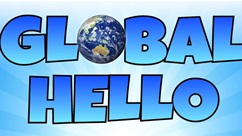Check out the Global Hello guide!
K-Zone acknowledges the Gadigal people of the Eora Nation as the Traditional Custodians of the lands on which this product was made. We acknowledge the contributions of all Aboriginal and Torres Strait Islander peoples to the continued traditions of storytelling across Australia. We pay our respects to Elders: past, present and emerging.
GADIGAL LANGUAGE
The Gadigal people are the traditional owners of the land that Sydney was built on, with the area south of Port Jackson, covering the Sydney central business district, and stretching from South Head to Petersham. The Gadigal are one of the seven clans who became known as the Eora people.
GAMILARAAY/KAMILAROI LANGUAGE
The Gamilaraay or Kamilaroi people are the traditional owners of a vast area in north-central New South Wales. The name ‘Gamilaraay’ consists of two parts; ‘gamil’ meaning ‘no’ and ‘araay’ meaning ‘having’. The name translates to ‘the people who have “gamil” for “no”’, which means the group of people who use the word ‘gamil’ to say ‘no’. For example other names for groups in New South Wales and Victoria use a similar method: the western neighbours of the Gamilaraay, the Yuwaalaraay, say ‘waal’ for ‘no’.
KALA LAGAW YA/KALA KAWAW YA LANGUAGE
Also known as the Western Torres Strait language (and many more names), this language comes from the central and western Torres Strait Islands, between Papua New Guinea and Australia.
NGUNNAWAL LANGUAGE
Ngunnawal or Gundungarra is the traditional language of the Ngunnawal and Gandangara people, who are the traditional custodians of the land in the Australian Capital Territory.
PALAWA KANI LANGUAGE
Palawa kani is a constructed language, created by the Tasmanian Aboriginal Centre as a Tasmanian language based on reconstructed vocabulary from limited accounts of the various languages once spoken by the eastern Aboriginal Tasmanians. It is the only Aboriginal language used in Tasmania (‘lutruwita’) today. The term ‘palawa kani’ means ‘Tasmanian Aborigines speak’.
PINTUPI LANGUAGE
Pintupi is one of the varieties of the Western Desert Language (the largest language group of Aboriginal Australia), and is spoken by the traditional owners of the land in the area between Lake Macdonald and Lake Mackay, stretching from Mount Liebig in the Northern Territory to Jupiter Well in Western Australia.
PITJANTJATJARA AND YANKUNYTJATJARA LANGUAGES
The traditional owners of Uluru-Kata Tjuta National Park are called ‘Anangu’, and mainly speak Pitjantjatjara and Yankunytjatjara languages, while some people speak up to six Aboriginal languages. These are dialects of the Western Desert Language. ‘Anangu’ means people in Pitjantjatjara and Yankunytjatjara. ‘Pitjantjatjara’ means ‘the people who use “pitjanja” when they say “coming”’, while Yankunytjatjara means the people who use “yankunytja” to say “going”’.
TIWI LANGUAGE
The Tiwi language is spoken by the Tiwi people from the Tiwi Islands, within sight of the coast of northern Australia. The Tiwi language is the first language for most of the 2500 people living on the Tiwi Islands, and is one of the largest Aboriginal language groups in Australia. Wurrumiyanga is the largest community in the Tiwi Islands.
WIRADJURI LANGUAGE
Wiradjuri language is the traditional language of the Wiradjuri people, which is the largest Aboriginal group in New South Wales. The Wiradjuri people are the traditional owners of the vast area including the plains running north and south to the west of the Blue Mountains. Did you know that ‘kookaburra’ is a Wiradjuri word?
YUGAMBEH LANGUAGE
You probably spotted the friendly Borobi in the Global Hello guide in K-Zone’s October issue! Borobi is a cheeky blue koala who is working hard to revive the local language in the Yugambeh region of South East Queensland! There used to be more than 250 Aboriginal languages spoken in Australia, and now 90% of the languages are endangered. Borobi is proud to be keeping the languages alive! Even the koala’s name is an example of the Yugambeh language – ‘borobi’ means ‘koala’!
YUGARA LANGUAGE
The Yugara or ‘Jagera’ people are the traditional owners of the territories from Moreton Bay to the base of the Toowoomba ranges, including the city of Brisbane. Did you know the word ‘yakka’ comes from the Yugara word ‘yaga’, meaning ‘strenuous work’?
Check out the Global Hello guide!
Do you speak an Aboriginal or Torres Strait Islander language? Do you want to learn to speak one? Let us know in the comments below!








Comment Now!